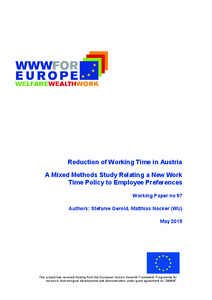Reduction of working time in Austria. A mixed methods study relating a new work time policy to employee preferences

WWWforEurope ; Gerold, Stefanie ; Nocker, Matthias
WWWforEurope - Vienna
2015
122 p.
reduction of working time ; working time
Working Paper
97
Working time and leave
English
Bibliogr.
"This mixed-methods study examines factors determining employees‘ desire to reduce worktime. The results of a binary logit regression model, based on data from the Austrian Microcencus 2012, suggest that employees who prefer shorter weekly working hours are older, higher educated and work longer hours in white-collar positions, compared to those who do not wish to change their hours. Gender differences are greatest in terms of household and family characteristics, supporting the ‘male breadwinner & part-time' model. Qualitative interviews have been conducted among employees who had the possibility to choose between a pay increase and equivalent leisure time via a new worktime policy (“Freizeitoption”) implemented in 2013. The results suggest that employees with higher education tend to reduce worktime. The fact that money is valued from a long-term, security perspective, as well as the tendency of assessing work performances by output indicators can be regarded as major obstacles for worktime reductions."
Digital
The ETUI is co-funded by the European Union. Views and opinions expressed are however those of the author(s) only and do not necessarily reflect those of the European Union or the ETUI.